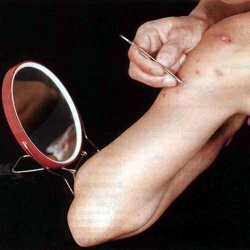Catatonia
 Catatonia is a psychiatric symptom that signals an expressive disorder in the psyche. Catatonia in modern hospitals is a syndrome that is not easy to meet, due to powerful neuroleptic treatment. This symptom is quite bright and obvious in diagnosis, but now you can see only a few inclusions of this syndrome. The presence of such catatonic inclusions indicates a poor prognosis and it is stopped with complications. Quite often, people with such a syndrome absolutely do not give in to medicinal preparations and have neuroleptic syndrome with intolerance of psychotic drugs.
Catatonia is a psychiatric symptom that signals an expressive disorder in the psyche. Catatonia in modern hospitals is a syndrome that is not easy to meet, due to powerful neuroleptic treatment. This symptom is quite bright and obvious in diagnosis, but now you can see only a few inclusions of this syndrome. The presence of such catatonic inclusions indicates a poor prognosis and it is stopped with complications. Quite often, people with such a syndrome absolutely do not give in to medicinal preparations and have neuroleptic syndrome with intolerance of psychotic drugs.
The state of catatonia is quite bright and often can manifest itself as dangerous for the life of the symptom-complex, which requires hospitalization.
Catatonia - what is it?
Catatonia is derived from the Greek word to stretch or strain. The origin of this comes from the symptomatology of the pathology, because in the catatonia the muscles are stretched to the limit, as if stretched.
Catatonia is not a separate symptom, but an entire symptom complex that is characterized by diverse manifestations associated with all spheres of the psyche. The most characteristic disorders of catatonia have an underlying motive and a fairly vivid picture. For the first time, catatonia was described as far back as the middle of the 19th century by a fairly advanced physician, Kalbaumom, and was immediately identified as a separate pathology. Over time, two psychiatric gurus took catatonia to the form of schizophrenia. This with a small gap in time was made by Krepelin and Bleuler. This was done at their peril, because then the reformism was not welcomed.
The state of catatonia is characterized by a clearly distinct structure, subdivided into catatonic stupor and the same kind of excitement. According to the American classifier DSM 5, which will soon be introduced in our country, catatonia is characteristic not only for schizophrenia. Now the concept of catatonia is much more extensive and can be an adjacent diagnosis, as it is revealed in a variety of other conditions. Since most specialists are used to the idea that catatonia is psychiatry and, at the same time, a serious form of schizophrenia, the treatment is often chosen incorrectly, because there are a lot of symptoms of such catatonia that arise completely in other conditions and not only with BAP, but also with some poisoning, drug treatment, especiallypowerful drugs.
Febrile catatonia occurs with the same schizophrenia and symbolizes a very toxic( lethal) appearance. It is mainly expressed in the presence of toxic effects with explicitly confirmed catatonia.
Regressive catatonia is more typical in childhood, with her behavior taking the form of regressive behavior.
Catatonia does not have age restrictions, it can also develop in children. There are many types of catatonia, among them the most typical lucid and onyroid catatonia. Naturally the most common form is simple, and febrile catatonia is the most dangerous and due to its toxicity, which leads to lethality.
Causes of Catatonia
Catatonia is not a common syndrome, but its causes are not so few. All of them in the bulk are associated with the psychic sphere and brain disorders. Individual affective disorders, and especially their manic manifestations, may have some inclusions from the described pathology. The most common cause is schizophrenia, and catatonia allows you to diagnose a catatonic form, which is one of the rarest and characterized by an unfavorable course.
In sad cases, post-traumatic stress disorder, which is associated with stress, can also be manifested by catatonia. Postpartum disorders that affect the psyche, especially hysteria, are also characterized by torn intermittent catatonia inclusions.
In children this symptom is not so pronounced, it is natural for catatonic schizophrenia to be possible, but it also often occurs in autism, a disease that develops in children with a special mindset. Individual research experiments have revealed that up to 19% of children with autism suffer from this problem, which causes even greater inconvenience and is very worrying. With mental retardation and developmental disorders, children may also exhibit such symptoms, but this as a casuistry should be very cautious. You can notice a lot of such inclusions, so do not immediately exclude them from this symptomatic series.
Many neurological diseases can also manifest themselves as such problems. Tourette's syndrome, for example, is a syndrome that, even without catatonia, makes life very difficult for its owner. All this is connected with a number of problems, because of sudden, violent actions. And when all these unpleasant actions are aggravated by the catatonia, then this does not please anyone. Temporal epilepsy or ictal catatonia is the name for catatonia related to a seizure, which in some cases acts instead of a seizure. Naturally, the anamnesis, burdened by injuries, especially craniocerebral, as well as strokes. The tumor of the brain, depending on the location, gives a variety of pictures, but in part they can be joined by symptoms like catatonia. Postencephalitic syndrome with various injuries, as well as many pathologies with lesions of the pale sphere, frontal lobe, thalamus, and parietal lobe.
Although catatonia is a very specific symptom, it is still capable of manifesting itself under classical somatic pathology. Thrombocytopenic purpura with an idiopathic underlying background, like many metabolic disorders, is extremely rare in its spread of endocrinopathy. Viral infections, especially severe, by type of HIV, severe childhood illnesses, in particular rheumatic attacks, typhoid fever, complicated by psychotic manifestations. Autoimmune diseases, especially vasculitis, Wilson's disease, marked lack of oxygen, Thea Sachs pathology, heat stroke. But all this somatic pathology is very rarely accompanied by catatonia, more in the casuistry series. But taking medications is a very common cause. It is characteristic that in patients with catatonia the administration of neuroleptics aggravates it, leading to severe conditions. Drugs and substance abuse can also push the emergence of catatonia. And they sing out another cryptogenic or idiopathic variant, the catatonia of an unexplained etiology. Many seemingly harmless drugs: Ciprofloxacin, benzodiazepines, corticosteroids and anticonvulsants can also lead to such conditions, with which not only their reception, but also a sharp cancellation.
Symptoms of Catatonia
Catatonia is a massive symptom complex that has the same massive structure. Several states are categorized as catatonia, but none of them is unsafe and indicates a serious violation.
Catatonic excitement is referred to the sphere of emotional and volitional impulses. It has several characteristic symptoms and is divided into several subspecies. The pathetic manifests itself as a gradual aggravating excitation, while the motor component is expressed moderately, like the speech component. Speech, as a rule, pretentious, even slightly pretentious. An invariable symptom in catatonia is echolalia, repetition of the same words heard from other people. Mood pathologically elevated - hypertension in certain situations right up to exaltation. The behavior is very alarming, because a person is excited, laughs for no reason, completely illogical. In some cases, this excitation is capable of transitioning to gebefrenic, creating a transitional form between these two states. Consciousness is basically clear without gross deviations. The impulsive subspecies of catatonic excitation are much more acute. Actions are fast-paced and bear cruel, destructive consequences. Characteristic is active negativism, which manifests itself in the desire to do absolutely the opposite of what they say. Here, all echo symptoms are expressed, as a variety of repetitions: echolalia - the constant inheritance of the same phrases after another person, echopraxia - the inheritance of the same movements, echomymia - the inheritance of facial expressions of the person who is talking with him. Sometimes there are perseverations - this is a stucking of people on identical issues, for example, you asked how his name is and he did not answer, then you asked how old he is, and he will say his name. Often, such individuals are capable of acting destructively, more aggressive and prone to self-aggression with damage.
Catatonic stupor manifests itself as motor retardation. The mutism, that is, complete silence with the preservation of the speech apparatus, is sufficiently expressive. The muscle tone is increased, up to the wax flexibility, if it is possible to give such a person any uncomfortable position, she can stay there for a long time. Such a muscle tone has the term catalepsy. Characteristic of the symptom of the gear wheel, that is, the movement of the person performs intermittently. Violated instincts, so the patient stops eating, in some cases it forces them to feed them through the probe and transfer to intensive care. When stupor with catatonia is characterized by passive negativity, that is, the person simply does not follow any instructions. Characteristic is the reaction to a whisper, with complete silence during the speech of the usual tone. In severe cases, they immovably lie in bed in an embryonic position and if they take the pillow from under their head, they keep their head above the place where the pillow was - a symptom of an air cushion. Often patients wear a hood on their head and sit for a long time in this position - a hood symptom.
Catatonia is characterized by stupor transitions into excitation and backward. In this case, if you offend a person in a stupor, he will not answer, but, having gone into catatonic excitement, he can even kill the person who has offended her. All these states are accompanied by hallucinatory experiences, usually with a pronounced affective component. There are also delusions. Catatonia is characterized by stereotypes - the inheritance of the same movements.
Lucid catatonia
Lucid catatonia displays its symptoms as a separate kind of catatonia, the so-called simple catatonia, which is expressed by all the standard symptoms of catatonia, but it has its own peculiarities.
Lucid catatonia in its component enumeration has the most stupor with negativism, negativism, as a rule, passive. This stupor in the main body with obvious numbness, while the psychoactive symptomatology is completely absent. Often, such catatonia is characterized as transparent, without side-effects, and clean. The orientation of the person is preserved, amnesia is not observed, since there are no substituting events, as is the awareness and understanding of the person around him. Personality is oriented in its own individuality and personal characteristics and in time space and place. People fully, fully aware of their actions, can control themselves and answer for their personal deeds and deeds.
In lucid catatonia, the tonus of muscle tissue is extremely high, the movement is slow in the sub-stump, or completely absent. Often, in addition to wax symptoms, it is possible to observe vegetation. Somatic and vegetative are very pronounced in catatonia, they are cyanotic limbs, swollen hands. Because of the increased parasympathetic, salivation, sweating, and seborrhea increase. The pressure can be quite variable and is not a criterion in the diagnostic indicators, while in the main it falls.
Lucid catatonia is most capable of manifesting itself with organic, having a structural composition, pathologies of the brain. Possible causes include various traumatic injuries, infections, tumors and neoplastic processes. Many types of intoxication are also capable of leading to such pathology, especially industrial intoxications.
Oniroid catatonia
Oniroid catatonia manifests itself as a separate rare manifestation, which can cause great damage to both the environment and the most suffering person. In addition to the classical, typical manifestations of catatonia, there is a serious psycho-product that determines the behavior and danger that a person can deliver.
When stupor with catatonia, a person stands for hours or sits motionless and observes scenic, and sometimes panoramic hallucinations. The combinations of catatonic manifestations are able to vary greatly, but psychoproductivity remains characteristic of this subspecies. Significant deterioration of catatonic stupor with the presence of pathological reflexes, proboscis stretching of the lips is also characteristic for this form of catatonia. With a stupor with a catatonia, excitement grows and leads to impulsive deeds. This form is characterized by pronounced affective inclusions such as rage, anger, sadness, aggression. Kind of affect and mood depends on the composition of psycho products. In the case of onyroid catatonia, in addition to hallucinatory experiences, characteristic delirium is present. Excitation is able to reach exaltation and euphoria and go into a state of gebefrenia.
When hallucinations and delirium are added to the catatonic stupor, the person stiffens, venturing into viewing his experiences. Consciousness is disturbed, mainly in the form of an onyroid defilement. After exiting this state, most of all amnesia, if the person and can tell something, then this is basically the experience of psycho products, and the real events are deleted.
One-aireoid catatonia occurs in schizophrenia, namely, in the catatonic form. Then automatisms of psychic genesis are added to the typical psycho products.
Febrile catatonia is more typical for a simple form, although it can produce psycho products with high intoxication. Regressive catatonia is characterized by regressive behavior, for example sniffing everything or licking, like an animal. The state of such catatonia is more characteristic of children.
Treatment of catatonia
The state of catatonia is only stopped in a psychiatric hospital, and this is obvious, since the condition is very unstable, it easily passes from one to the other subspecies.
Benzodiazepines that contribute to the withdrawal of fear are effective enough for the state of catatonia: Alprozalam, Leksotanil, Diazepam, Transxylium, Clobazam, Tavor, Nordazepam, Oxazepam, Prazepam, Chlordiazepoxide, Rivotril, Nitrazepam, Musaril, Lendormin, Loprazolam, Itan. It is important to remember the addiction of the drug, which requires justification in the documents for their admission.
After an attempt to medication with a lack of proper effect, electroconvulsive therapy is used. In general, catatonia is not a very well-tolerated pathology and has many drug-related contraindications. And, if the drugs are selected depending on the cause of catatonia, because in organics, many drugs are not only ineffective, but also aggravate the condition. What can not be said about electroconvulsive therapy, which is effective for all causes of catatonia. With malignant catatonia with neuroleptic syndrome, ECT is a method of choice.
With neuroleptics in catatonia, there are some difficulties, because cathotonic patients really tolerate neuroleptics. But there is evidence of their useful use, suitable drugs can be considered Risperidone, Azaleptin, Quererone. With very expressive stimulation, there is a need to use haloperidol and aminazine. Carbamazepine, as well as combinations of lithium with antipsychotics are also quite effective. There are positive data on the use of many drugs for demented individuals: Nootropics, Amantadine, Memantine, which are antagonists of methylaspartate. Glutamate acts on those receptors that block the preparations of the antiglutamate series.
In many cases, persons with catatonia require intensive therapy, especially in the absence of natural nutrition. Nutrition through a nasogastric tube is required, as well as the use of nutrient fluids: Rheopolyglucin, Tresol. Then the muscle relaxants are added: Dantrolene sodium, and also Bromocriptine from a number of dopamine antagonists.
Febrile catatonia is suppressed in addition to the named drugs, and a decrease in toxic manifestations. To do this, detoxification is carried out with the help of enterosorbents, various saline solutions and glucose.



